The real map of China
The Real Map of China
China is a great country, which is constantly growing in strength. China has huge workforce, strong economy and a powerful army. However, the superpowers and empires were falling, even though it seemed they would be eternal. Every time I look at the map of China, I wonder what would happen if China ceased to be a power, and if it was divided. In the article “the Real Map of China” I try to answer the question, what would the territory of China look like if it was only left with the historically Chinese lands, and where does the Han Chinese race originally comes from.
The large territory of China
Every time I look at a map of the People`s Republic of China I wonder how much of that land would remain in China if we left only what is truly Chinese. In the same way after the collapse of the Soviet Union we could see how many countries the Soviets occupied and how many they lost. Maybe one day the People’s Republic of China will also collapse, and then it would become a relatively small country, more or less of the size of France. Real China where the true Chinese culture and the Han Chinese come from originate only from the eastern part, while the expansion of the Han Chinese and the Han culture is a result of their invasions and occupations.
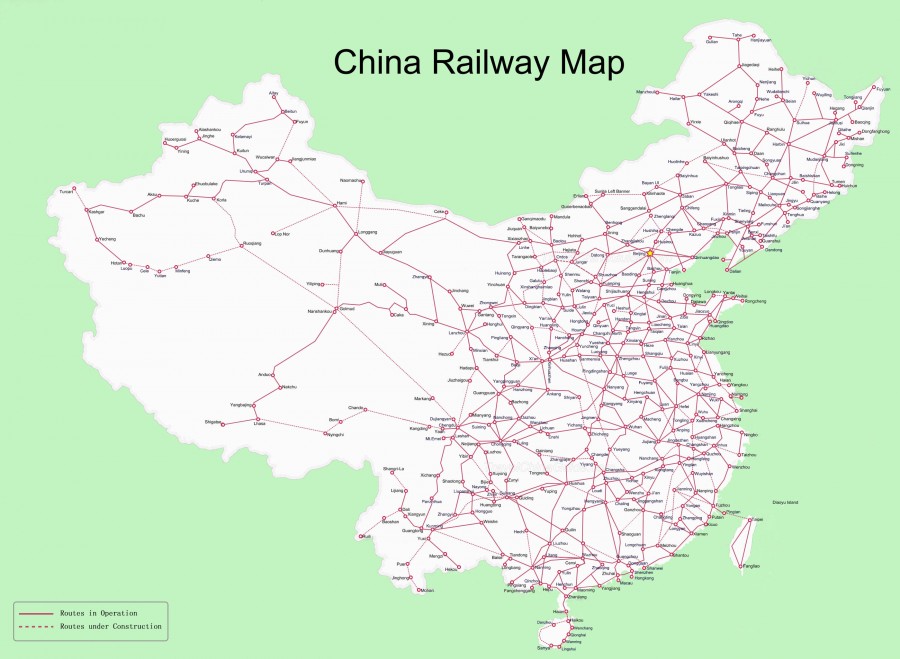
Good transport is the basis of effective occupation, what makes sense especially in the case of the huge population of China. The Chinese government was so ‘generous’, that every Chinese who planned to settle in the occupied territories, such as in Tibet or Turkestan, didn’t have to pay for a train ticket. The Dalai Lama warned that building railways from Beijing to Tibet would lead to the denationalization of Tibetans. (Interestingly, from a European point of view such politics in China is defined as ‘occupation’, but the same policy of denationalizing Europeans in European countries is referred to as ‘multiculturalism’).
The purpose of this article is to approximate the actual map of China, although taking into account the history of Ancient China the author does not have any opinion whether all the special administrative and the autonomous regions should be separate countries or not. However, due to protection of cultures and disgust towards communism the author is certainly in favour of their full ideological, ethnic and cultural independence.
Here are the territories of the People’s Republic of China which I dare to question as Chinese:
► In the north there is a province of Inner Mongolia, which territorially should be a part of Mongolia. Currently there are only 15% of native Mongolians living there. They are however Chinese citizens because they don’t have choice.
On the other hand the Mongol Empire was infamous for its brutality and was the largest by landmass. Mongols had conquered the whole of China, an on the throne in Beijing they had Yuan Dynasty, which was Mongol. Due to the current, tragic location of Mongolia I think that Mongols can consider themselves very lucky that they have their own country, because surely the Mongol nation is far from innocent.
► In the north-east there is Manchuria, which was used to be a war theatre between Russia, China and Japan, and which was fully drawn into the People’s Republic of China in 1949, after the Communists seized power. Manchuria is usually called “North-East” or “three eastern provinces” (san don sheng), which include the provinces of Heilongjiang, Jilin and Liaoning, although historically this unofficial country was also partially in Russia and Inner Mongolia. Today the outright majority in that part of PRC is Han Chinese.
We may be sorry for conquered and non-existent nations, but Manchurians invaded China in 1644, and they also invaded Korea. Later, they got conquered themselves by their powerful neighbours.
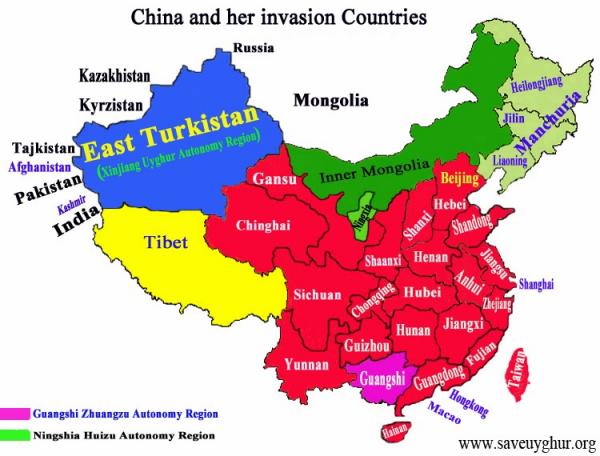
The map of China, including the conquered countries, which were forcibly drawn into the People’s Republic of China. We can see Tibet, East Turkestan, Inner Mongolia and Manchuria, among others.
► In the south-west there is Tibet, the Himalayan plateau drawn in by chairman Mao during his ‘cultural revolution’. I’ve also been to Tibet, and in the cultural and racial terms Tibet is definitely not China. Tibetans have their original architecture, their own customs, their language and their own version of Buddhism, which is different than the Chinese Buddhism. Tibetans also have a very close attachment to their mountains, which the Chinese simply lack.
However, on the other hand Tibet used to attack and murder too. Tibet controlled Nepal from the VII to the XII century, and because of that Buddhism arrived to Nepal.
It is also worth mentioning that the province of Qinghai, which is part of the Tibetan Plateau outside Tibet has a significant Tibetan minority of as many as 22% of the total population of that province. As a result of it Qinghai is an important centre of Tibetan culture outside Tibet, which offers photographers beautiful photo opportunities of Tibetan stupas and monasteries at the background of mountains and wide open spaces.
► In the north-west there is Xinjiang Uyghur, which is also called Chinese Turkestan, even though it is yet just another very non-Chinese country in the territory of PRC. Turkestan is also culturally very different from China because it is a Muslim country with Central Asian traditions, and Turkish roots. Uygurs speak a language which originates from Turkish, they have a carpets weaving culture and a strong attachment to grazing animals on vast pastures, just like it is in Kyrgyzstan and Uzbekistan. Apart from that, Uyghurs who are the Silk Road people of Central Asia, in racial terms have nothing to do with Chinese. They resemble Kyrgyz people, Uzbeks and Afghans. Xinjiang Uygur is therefore another very non-Chinese country in every aspect.
On the other hand Muslims have murdered, raped, abused and enslaved others since the day they appeared on the planet Earth, and it is a part of their culture, in exactly the same way as carpet weaving or romancing goats in the bosom of nature. If Vienna had not been defended twice against the Ottoman Empire (1529 and 1668), there would be no Europe anymore. In that case it is hard for me to feel sorry for Muslims, especially that there is an unbreakable ethnic kinship between Uyghurs and Turks (Ottomans). Today, history repeats itself again, because again we have to defend Europe against Islam.
► In the south-east there is Hong Kong, the economic power of the world, first bred on the British colonialism. Then there was a legal agreement involving the lease of Hong Kong island and its New Territories for 99 years, which occurred due to economic weakness and greed of China. In those times it was the best solution for China, which as a result pays her off very well. Hong Kong is very different from Chinese provinces, because many things look British and English is widely spoken.
Hong Kong is based on the concept of ‘one country, two systems’.
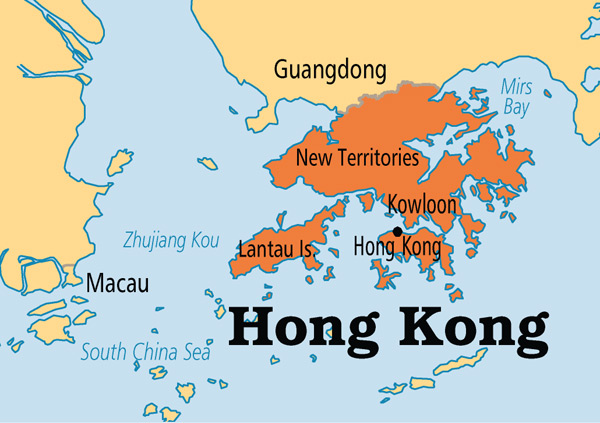
The map of Hong Kong and its New Territories.
► In the south-east, about half an hour by boat from Hong Kong there is Chinese Las Vegas, which was a Portuguese colony called Macao. In this case there was also a lease agreement set up to profit both China and Portugal. Macau was a Portuguese colony and territory under Chinese authority from 1557 until 1999, when it was handed over to China and became the Special Administrative Region of PRC. Today Macao still looks like little Portugal, with architecture and street names in that language.
Macau is based on the concept of ‘one country, two systems’.
When Mao Zedong (other correct name: Mao Tse-Tung) took power in China in 1949, the opposition party fled to Taiwan and set up their separate country – Taiwan, officially named: the Republic of China. Taiwan however was a part of Ancient China, and this is the reason why The People’s Republic of China does not recognize its independence.
In view of the above I don’t consider China to be totally stable. Despite its economic and military power a small mistake or external intervention could lead to a string of nationalist revolutions, which would either result in the partition of the People’s Republic of China into small countries, or a massacre of ethnic minorities in order to maintain control over the entire territory of current China. The problem for China would be also that chaos weighing up the map of China could arise in many parts of this vast country at the same time. According to me, the survival of any country is not entirely certain.
At present however Han Chinese accounts for over 90% of China’s population, although in some provinces occupying very large areas, Han Chinese people who are hated by certain minorities account for only 50%.
The risky provinces of China
As a curiosity I also want to give information on demographics of the other two Autonomous Regions of China, which are autonomous because of ethnic minorities.
For example Guanxi province where population is around 47mln, Han Chinese stands at only 62% of the total population. A big minority are Zhuang people (32%), Yao (3%) and several others which together account for about 3%.
Another region of such type is Ningxia province, with the total population of over 6 million, where Han Chinese stands at about 62% and the Hui minority at 34%.
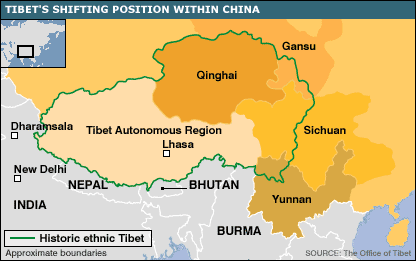
Map of Tibet in the People’s Republic of China. The historic areas of Tibet and the Tibet Autonomous Region designated by the Chinese government, is a policy of Tibetan land robbery in practice.
In case of weakening or breakdown of China Qinghai could also become one of the ‘risky provinces’, and it could happen for several reasons. Qinghai is located on the Tibetan Plateau, even though the province is not a part of the Tibet Autonomous Region. The overall population is about 5,5 mln, of which Han is about 54%, Tibetan 21% , Hui 16% Tu 4%, but there are also Mongols (about 2%), and Salar people (less than 2%). Qinghai is therefore a cultural and linguistic Tower of Babel, and each of the groups wants to feel like a master in his own home. In addition, Tibetans have territorial claims for Qinghai province and parts of Sichuan, Gansu and Yunnan, as parts of the Tibetan Plateau and the Tibet’s cultural and ethnic heritage.
For the time being they are very stable regions of China where all communities live in harmony, and for example Guangxi province due to its natural beauty is a great tourist attraction. The Chinese government should realize that if The People’s Republic of China begins to fall apart, then there would be clashes in those two provinces because minorities would want to be independent. What’s more, those two provinces have huge geographical advantages because they are located on the edges of China. Guangxi borders Vietnam and Ningxia borders Inner Mongolia, what means that if China weakened and if there were US bases in the surrounding countries, anything could happen.
(Ethnic minorities are a dream method used for fragmenting the nation by creating racial and cultural enclaves, and even to destroy it. Meanwhile, the stupid English still mix with dark-skinned races and they are proud of themselves, because they are ‘not racist’. Idiots !!!)
I always write my articles in a very honest way, and this time I wanted to explain how the situation looks like from the Chinese point of view. Ancient China covered the entire territory of todays People`s Republic of China including Taiwan. According to this Mao Zedong ‘did not seized anything by force’, but only took what had already been a Chinese property. This is exactly what China holds on to, as its innocence policy.
In addition to the above Mongolia, Tibet and Muslims also attacked and looted everyone around them for thousands of years and that’s why before we judge China, first we should learn a little more about the history of China and all the surrounding countries too. Unfortunately, sooner or later there is only anarchy in politics.
Out of all the occupied countries of the PRC I feel the biggest compassion towards Tibet. I used to think that it would be good if Tibet could become a European protectorate on a lease, but today when Europe is suffering from multi -“culturalism” and promotion of perversions, I think that perhaps it is better to leave Tibet as it is.
“China” outside China
Unfortunately appetite grows with eating, what means that China also wants territories of neighboring countries, including islands in the South China Sea. In addition, where China has no territorial claims, it wants to control other countries politically or economically, and if this option does not work also militarily.
Claims on seas
On South China Sea and East China Sea, China has endless territorial claims with regard to Paracel Islands, Spralty Islands, the Senkaku Islands (Diaoyu), Scarborough Reef and part of the Gulf of Tonkin. It is a conflict where the countries involved are China (People’s Republic of China), Taiwan (Republic of China), Vietnam, Brunei, Philippines, Malaysia and Japan. The PRC also claims the whole of Taiwan and its offshore islands, and additionally it claims maritime jurisdiction to the Indonesian islands of Natuna and Anambas.
Due to the tragic history, the greatest emotions arouse because of the conflict with Japan over the Senkaku islands, although in my point of view disputes on both seas are serious between all the countries involved in those claims.
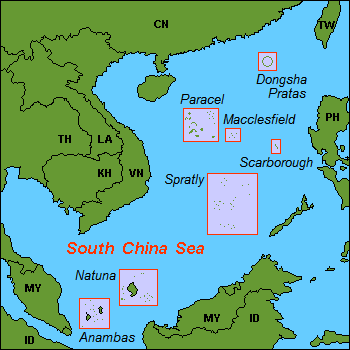
China’s claims on the South China Sea. China’s appetite is growing!
The islands have great strategic importance because they are the dream come true for the construction of military bases and ports, what means that China could easily control the entire basin of the East China Sea and the South China Sea. The region is also of great importance due to trade and transport, what means that China could further charge for mooring in ‘its ports’, and could completely control the trade and transport across the region. In addition the waters around the islands are rich in fish and deposits of natural resources, such as gas.
Claims on land
In addition to the claims on the two seas, China has also territorial disputes on land. From India China demands a part of the Indian state of Arunachal Pradesh, including Tawang, as per the McMahon Line, and they even call it ‘Southern Tibet’. It is a huge area covering 90,000km2 which China is not going to give away, even though it does not belong to China. In addition, China also wants Aksai Chin region, located in Jammu and Kashmir in the area of Ladakh, which covers another 38.000km2.
Apart from the above India has another problem, which is called the Siliguri Corridor or The Chicken’s Neck. It is a narrow piece of land belonging to India, which joins the main part of India with its north-eastern states, and it borders Nepal, Bhutan and Bangladesh. Siliguri Corridor is geographically a very delicate region of India, and even though China does not have any claims to that region, in case of conflict it could completely cut off India from its seven north-eastern states and the Himalayan Sikkim. Siliguri Corridor is not only the soft part of India, but also a great geographical advantage of China, and although this issue is not discussed by any of the parties, in an emergence of a conflict it would certainly come up in the media as the hot zone because of concentration of Chinese troops.
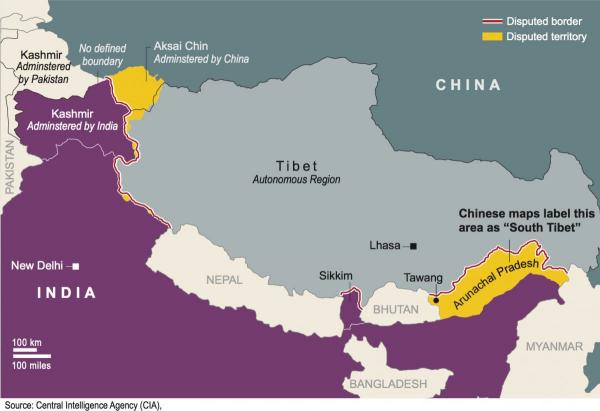
China’s territorial claims are huge.
As if the above was not enough, China has territorial claims with respect to small Bhutan. According to China, the country should be given the Doklam Plateau (269km2), which is situated strategically near the Chumbi Valley, and which by the way a headache for India. China also claims the valleys of Jakarlung and Pasamlung (total 495km2).
Bhutan is a tiny country represented internationally by India, what China cannot stand. Besides, India in exchange for ‘protection’ does not allow Bhutan to move closer to China, what irritates China even more. China’s territorial claim towards Bhutan is a dirty political game between the two regional powers, between China and India.
In addition to the above China dominates economically especially in the northern part of Burma, entire Laos and whole of Cambodia, and among many other countries China is economically very active in Nepal, Vietnam and the Philippines. The expansion of China has no end. In my opinion, China is playing a very dangerous game.
The grotesque role of America in Asia-Pacific
In the Asia-Pacific region the most grotesque role is by far played by America, whose president gives emotional assurances to the small countries, that it would protect them from China. That tactic is a typical way of the American strategy of domination on the other side of the world, by giving a false sense of security to those countries which America would never fight for. According to me every country involved in territorial claims against China can count only on itself, but as long as there isn’t an open attack America gains political power and economic gains from the sale of old weapons.
- autonomous regions of China
- China land claims
- China's maritime claims
- Chinese Taipei
- expedition to East Asia
- free Tibet
- great China
- Hong Kong Special Administrative Region
- Inner Mongolia
- Macau Special Administrative Region
- Mao Zedong
- map of China
- occupied Tibet
- Outer Mongolia
- People's Republic of China
- Taiwan China
- territories of the People's Republic of China
- US military in the Asia Pacific region





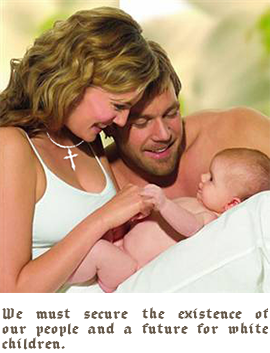






























SinoLog
Mongolia was not conquered by China the way Tibet was. It was a part of Qing and then post-Qing China for several centuries already. It was the Soviets who “asked politely” to give a piece of land to Mongolian comrades. This way creating a buffer state. If you look at the maps used by the TAIWAN government until recently – Mongolia is still part of China (as is Tibet). Or course many modern Taiwanese consider to be an independent, “new” country – but the original idea was that KMT would take Nanjing and Beijing (and Kathmandu and Lhasa) back.
Btw, What kind of biased historiography is that to JUDGE nations? “Innocent”, “guilty”, nations don’t work like that. You are so full of ideology.
Yes, Tibet was taken by China by force. But some Tibetans (or related peoples and tribes) joined in. Tibetan people were not united in one vision of nationality. Many clans were against each other. Also, Tibet was part of Qing Empire for most time in modern history – the periods od independence where really short. I’m not saying that it SHOULD be a part of China. No, I wish it could be sovereign, believe me. But ignoring the fact that it was part of China for hundreds of years is neglecting facts.
What unites some (not all) Tibetan is religion. If they had a country it would be an Iran] model one: with state faith and ruled by the priestehood. Dalai Lama since several years repeats that he doesn’t want war or revolutions, his only wish is for the traditions and Tibetan script to be preserved. A wise man. An utopist, though?
As for East Turkestan, there is no unity there whatsoever, there is no nation or ethnicity that could claim it. It’s inhabited by Kazakhs, Mongols, Han, Uyghur. If you give it to Uyghurs (or to Turkey as some would wish for), then other inhabitants would become angry. This region is a borderland and has mixed population since two thousand years. It’s sad, but no solution can establish peace there. War-mongering will not help for sure. What China needs is better government and more humane approach to multiculturalism that is inevitable part of their heritage.
And Ningxia? It’s classic China. it doesn’t differ from other part od China. It’s autonomous status is an experiment similar to the Jewish Oblast of the Russian Far East. It was created to make the. Muslim population happy, but it doesn’t mean that this region has a Muslim character. Muslims live all over the country and mosques are everywhere you go in China. Ningxia is no different. Hui people speak Mandarin and are basically Han Chinese in mentality except the religion. It’s hard for me to image they would like co claim any sovereignty or land in 21st century. The peasant revolutions and Muslim riots are a long forgotten.
KOMPAS TRAVEL
@AL
1.Thank you for pointing out the misleading map. I agree it is bad and I was going to exchange it with a better one. I might even do it today. A much more accurate map is in Tibet section of this site. Thanks.
2.Term “Manchuria” is used not only by Japs and in my point of view the name “north east” is not sufficient enough. I agree that the majority there are Han-Chinese but it is not their racial fatherland. In many parts of France Arabs are the majority although they should get out.
3.I don’t think you have read my article with full understanding. I stated that Tibet should not be a part of China due differences in race and culture but on the other hand I also stated that Tibet used to be a part of the ancient China and the Chinese stick to this version as their innocence policy. From my experience Tibet is a Chinese police state.
Also, both versions of the the chairman’s name are correct. It is Mao Tse-Tung or Mao Zedong.
MM
~AL
You have put up a very misleading map here! Even if you believe Tibet is not part of China, please get the size right. Your “Tibet ‘ is at least three time s of its actual size.
Moreover. “Manchuria’??!! Nobody would use that name unless your are a Jap. The correct name is ‘The North East’ and 99% of the population there is Han-Chinese.
Hey Pal, Please get the facts straight.
KOMPAS TRAVEL
@ Jack Spencer.
Thank you for taking the time and yes I shall give you your freedom of speech and even more.
As I understand according to you I am an “inaccurate racist”. Thank you. Here are the answers:
1. Chinese “cultural” revolution was about uniting war torn country into one under one strong China – at the cost of millions dead by starvation and disease under the brutal communist banner. I don’t appreciate that kind of “culture”. The term “cultural revolution” is commonly used.
2. The word “Catholic” is also there to remind all liberals and leftist traitors that we do exist. Many people don’t like that word. They would prefer “liberal” or “gay” as I presume.
3. This one will be a surprise for you but we learn something new every day. Romanization of Chinese is the use of the Latin alphabet to write Chinese. Because of that Mao Zedong can be also called Mao Tse-Tung. Both names are correct.
Your reaction is typical for native English speakers who can speak and write only English.
4. Yes, I am a Eurocentric because I am European. I don’t think that Asians need Europeans to defend themselves. I think that Europeans should defend themselves from Asians, Africans and other races. You have judged me to quickly.
5. I have good knowledge of the ethnic face of China and I showed it in my article and in different country’s sections. However: huge numbers of Han Chinese keep it safe for the Han race to survive. Other racial minorities in China although different they are still yellow and still slitty eyed.
6. I’ve never said I was an expert but I don’t recognize such thing as Chinese descent or for example an Arabic descent, as it would suggest for example that there are “British people of Chinese or African or Arab origin”. An Arab or a Black man who has lived in England for 3 generations is still an Arab or Black. There is only a pure White race or a person of a different kind. You are White European and your bloodline is your passport.
I understand that especially to the Left my comment has been hardly amusing and difficult to digest but at least try to live with a different point of view. Also, try to not to be so melodramatic when it comes to racism. It is just an artificially created term by the Left regime to build the White guilt.
MM
~Jack Spencer
“Kompas Travel gives 100% freedom of speech in all your comments.” Are you sure you are willing to abide by that? Here I go…There are so many factual inaccuracies in this article that I don’t even know where to begin. It isn’t worth anyone’s time to go through every single factual inaccuracy and instance of racism so I’ll just grab a few in no particular order.
1. “cultural” revolution. There was a revolution. Its target was China’s culture. It had a dramatic impact on the culture of China. What about “cultural” do you find so appalling?
2. At least try to use a “Catholic” language. I’m just going to point my finger at that little tidbit and leave it at that. It doesn’t require any explanation. If you want to come across as “worldly” “well-traveled” or “not a completely ignorant bigot” then you should probably leave that out of the comment requirements.
3. You call Mao “Mao Tse-Tung”. Find one Chinese person who calls him that and I’ll personally send you a moon cake.
4. Your entire article is a Euro-centric rant that implies that Asians need Europeans to defend themselves. Go back to the 19th century where your ideas might be better received.
5. China is NOT a culturally homogeneous place, no matter how much Chinese society wants to convince you that it is. There is no monolithic “Chinese culture”. There IS Chinese nationalism. Judging by your material, you, like myself, are not a Chinese nationalist. Just because you went there doesn’t mean you’re an expert.
For clarification: “Jack Spencer” is not a Chinese name. I am not a wumao (which you obviously know about if you know even a little bit about the many controversies in China) and I am not Chinese. I too am a foreigner of European descent.